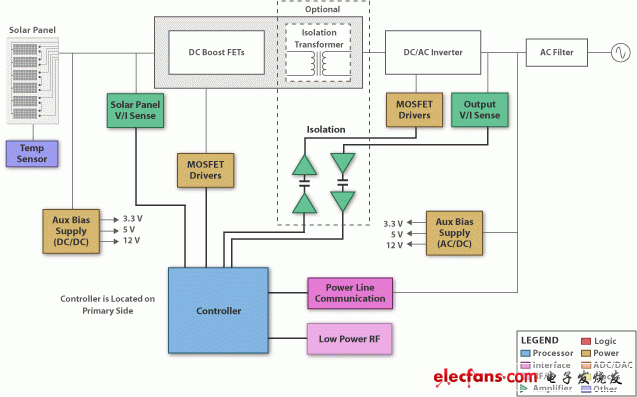Texas Instruments' Solar Micro Inverter Solutions
Design considerations
Solar micro inverter | solar panel system design
Solar micro inverter principle block diagram

Photovoltaic (PV) installations connected to a grid typically use an array of modules in series with a string inverter. The fast-growing architecture of micro-inverters converts the power of PV modules to the AC grid, typically for maximum output power in the 180-300W range. The advantages of micro-inverters are ease of installation, local maximum power point tracking (MPPT), and robustness to provide robustness to faults.
The core of the inverter is the MPPT algorithm that can be executed by a microcontroller or MPPT Controller. The controller performs the high precision algorithms required to maintain the panel at the maximum power extraction point while adjusting the DC-DC and DC-AC conversion to generate the grid output AC voltage. In addition, the controller is responsible for the frequency lock of the grid. The controller is also programmed to perform the control loops necessary for all power management functions. The maximum output power of the PV depends on the operating conditions and is constantly changing due to temperature, shading, fouling, cloudiness and time. Therefore, tracking and adjusting this maximum power point is an ongoing process. The controller includes advanced peripherals such as high precision PWM outputs and ADCs for performing control loops. The ADC measures variables such as PV output voltage and current, and then adjusts the PWM duty cycle based on the load to adjust the DC/DC converter and DC/AC converter. The complex plan is used to track the actual maximum even number in a partially shaded PV module.
A real-time processor designed to read the ADC and adjust the PWM in a single clock cycle is very attractive. Simple system communication can be handled by a single processor, and a complex system with complex monitoring reporting capabilities may require the use of a secondary processor. Current sensing is performed by a fluxgate sensor or a shunt resistor. For security reasons, it may be necessary to isolate the processor from current and voltage and the communication bus to the outside world. A delta-sigma modulator with integrated isolation is very attractive. MOSFET/IGBT drivers that handle higher voltages and include integrated sensing are also very attractive. The bias supply uses a DC-DC converter to power the electronics on the inverter. Communication functions are sometimes included so that users can monitor the converter, report power and operating conditions, and provide firmware updates. Power line communication (PLC) is often used to reduce wired or wireless (Bluetooth, ZigBee/IEEE 802.15.4, 6loWPAN) networking options.
This series features transparent LED screens, which are suitable for various indoor places and various stores, especially in storefronts with floor-to-ceiling glass windows. Installing the transparent screen against the glass wall has a very good effect. When the display is turned off, the audience can watch the indoor environment from the outdoors, and when the display is turned on, they can directly watch the content played on the display.It not only preserves the visibility in the store, but also can effectively display advertising videos to the other party, which is very practical.

Transparent Led Screen,Led Wall Display,Building Led Display Panel,Sport Led Screena
Guangzhou Cheng Wen Photoelectric Technology Co., Ltd. , https://www.nbcwdisplay.com
